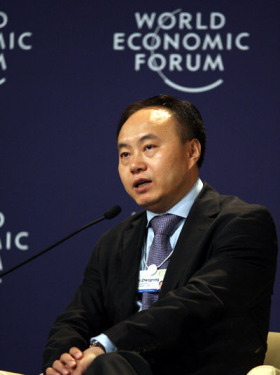Look at how the solar photovoltaic giant Shi Zhengrong re-emerged
 The excessively hot photovoltaic industry has ushered in an unprecedented liquidation moment to see how the founders of China's largest photovoltaic company have responded to the recession and learned from the pain of the bursting of the bubble.
The excessively hot photovoltaic industry has ushered in an unprecedented liquidation moment to see how the founders of China's largest photovoltaic company have responded to the recession and learned from the pain of the bursting of the bubble. The feast is no longer the entire Chinese photovoltaic industry as if it is painfully low. Over the past year or more, many of China's once-listed Chinese PV concept stocks have plummeted by nearly 90%. The market conditions turned bad in the fourth quarter of last year: As the largest photovoltaic battery manufacturer in China, Wuxi Suntech Power Holdings lost 6590 in a single season. Million US dollars, the gross margin fell to 0.6%. There are also peers such as Lin Yang New Energy and Jiangxi LDK LDK such as the latter, the latter single-quarter photovoltaic losses reached 133 million US dollars.
Although Shi Zhengrong stated that he had foresee the risk of bursting of excess photovoltaic capacity as early as last year, it was not until the third quarter that “what I did not expect was that the industry was still so hotâ€. At this time, Suntech’s gross profit margin for photovoltaic modules was also Keeping at 21.6%, Shide claimed that for the normal stocking needs, Suntech purchased silicon raw materials to meet the production needs for two weeks at a high price. As a result, the rapid downturn in the market caused this high purchase to directly cause Suntech to lose substantially in the fourth quarter. . According to estimates before Sun, Suntech had a net profit of 300 million U.S. dollars in photovoltaics last year, but its actual net profit for the year was only 111 million U.S. dollars, which is nearly half of that in 2007.
However, "If history repeats once again, I still do so." Shi Zhengrong insisted.
Shi Zhengrong said that as early as two years ago he himself realized that he was on the verge of a turning point in the photovoltaic industry, and judged that this year's photovoltaic industry will exceed supply. "If there is no financial crisis, the crisis of overcapacity in photovoltaic capacity will probably occur in June and July this year. The crisis caused this situation to occur six months in advance," said Shi.
However, outstanding sales figures and profits in the second and third quarters of last year have left Shi Zhengrong optimistic about the PV market. In October last year, silicon raw materials remained tense, and customers sent Suntech daily delivery. Suntech continues to implement the expansion policy and plans to achieve a capacity of 1400 megawatts of photovoltaic modules this year. Yangzhou, Yangzhong, Luoyang, Wuxi, and Shanghai will also expand several photovoltaic production bases at the same time, and strive to achieve 5,000 megawatts of capacity in 2012.
Contrary to what was expected, after November, the situation began to deteriorate markedly, and the prices of polysilicon, photovoltaic cells, and photovoltaic modules dropped one after another, and the rate of decline was surprising, exceeding Shi’s imagination. Today, the price of photovoltaic modules has dropped from 3.7/watt of previous years to 2.5 yuan/watt. So rapid heat-to-cool cooling almost made Shi Zhengrong wait to respond. The warehouse was already full of inventory. Up to the fourth quarter of last year, Suntech's total PV module inventory was as high as 231.9 million US dollars.
Shi Zhengrong had to go around and negotiate with upstream suppliers of photovoltaics to demand a reduction in the polysilicon spot supply price. In spite of this, the silicon material stock purchased at a high price in advance was still a “time bombâ€, and the impairment of polysilicon and some of the investment projects in the fourth quarter was close to 40 million US dollars.
At the end of November last year, when Suntech released its third-quarter solar report, Shi Zhengrong had determined that the operating data in the fourth quarter would be very bad. He began to desperately reduce investors' expectations of Suntech and announced that “the fourth quarter profit of PV will be zeroâ€. . In this situation, Suntech has no chance to remain alone in this vortex. "The general trend is reversed. You can't touch a stone when you touch a stone," Shi Zhengrong said.
In the next two months, Shi was scrambling to cope with sudden and sudden cooling. He held successive meetings of Suntech's management team to discuss countermeasures. The first decision made was to stop the expansion of photovoltaic capacity. In addition to photovoltaic projects in Yangzhou and Shanghai, all other projects were suspended and personnel were recalled. This decision can save Suntech a capital expenditure of 2 billion yuan.
Decisions made with this package include continuing to implement flexible employment methods such as elimination at the end of the year, slow recruitment of 2,000 trained employees, cancellation of monthly bonuses for all employees, and collective salary reductions by management. Shi Zhengrong’s annual salary is also lowered this year. It is 1 yuan.
With these rapid and radical measures, coupled with the support of the Wuxi municipal government and local financial institutions at key moments, Suntech's operations have gradually stabilized. However, internal and external doubts and concerns did not stop. At the beginning of January this year, there were even rumors that Suntech would lay off 4,000 workers and half of the production lines would stop production.
Application:
The electric cable tray system are widely used for:
1.railway bridge cables laying
2.highway bridge cables laying
3.petrochemical engineering cables laying
4.post and telecommunication cables laying
5.computer cables laying
Ladder Type Corrosion Resistance Cable Tray
Cable Trunking System,Grp Ladder Outdoor Cable Tray,Powder Coating Ladder Cable Tray,Grp Corrosion Resistance Cable Tray
Jiangsu Loncin Electrical Equipment Co.,Ltd , https://www.loncincabletray.com